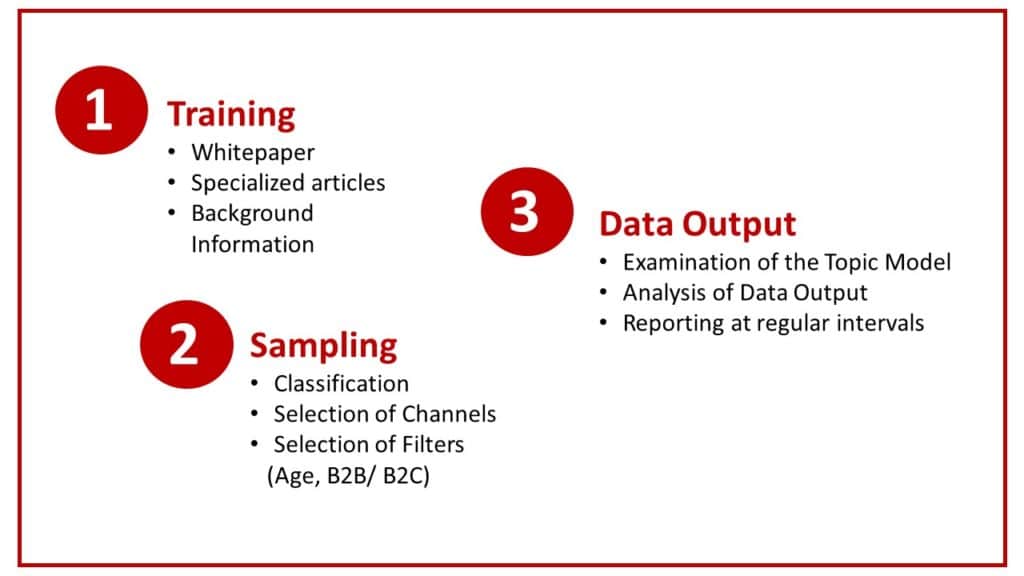
Artificial Intelligence in marketing, PR and journalism – sounds exciting, but how does it work?
Best Practices
Posted 19 Nov 2019
Insights into the methodology of the AI behind the Worldcom Confidence Index
We explore that question in our article using the example of the Worldcom Public Relations Group’s Confidence Index (CI) 2019, for which we and our partners used Polly’s Artificial Intelligence (AI) to gain unique insights into the mindset of CEOs and CMOs worldwide. For the Worldcom Confidence Index 2018, online content by CEOs and CMOs was viewed and evaluated globally. In order to increase the reach of the index and thus, the significance behind the figures, almost 60,000 social media accounts worldwide were recorded and evaluated in 2019. Compared to last year’s figures, this seems – and indeed is – humanly impossible. An exciting fact, which only the cooperation with an AI manages to achieve, is that Polly can collect data and facts across all languages. There are no language barriers, which makes an immense reach possible. Launched as a university project in Canada, the patented product of Advanced Symbolics Inc. has been popular around the world since 2017. In cooperation with the Canadian company, the Worldcom PR Group has created a cross-theme confidence index and trained the AI with the necessary information in months of work. After all, the way artificial intelligence works is similar to that of a human employee in the early stages.
For the algorithm to be able to classify the content on social media, it must first be trained. What style do journalists use in specialized articles? How do colleagues talk to each other during lunch? In the study, the AI must distinguish between different styles of conversation and this requires training. In relation to the Worldcom Confidence Index 2019, this was background information, articles, and whitepapers in different languages and with a regional context on the relevant decision-makers and issues that concern them.
Creating context is the next important step. For a balanced investigation, for example, political attitudes are relevant as a factor. In the US, media are increasingly taking a political stand and commenting on incidents according to their respective sides. In social media, one-sided comments might gain the upper hand. With the right training, the AI is able to compensate for major differences in a larger sample. In contrast to conventional surveys, the AI regularly issues samples of its work. In internal control procedures, the results are then analyzed and compared with previous results. Fine-tuning is the key to success here!
The aspect of data security plays a major role in the work of Advanced Symbolics’ AI. All retrieved and examined data is publicly accessible and the AI does not access protected data. Any user within the social network can view this data – the AI is only significantly faster in it. The collected data is encrypted within the sample pool and is only visible via generic IDs. Thus, no regressive personalization is possible in post-processing. As a result of the patenting of the AI and the underlying working method, the Office of Privacy Commission of Canada put the process through its paces and certified it in terms of data protection.
Within a Bayesian belief network, different classifications increase the statistical accuracy of the assumptions mutually. Thus, the model gains precision and is correct in determining age group, gender and group affiliation within a confidence interval of 85 percent. Classifications are the name, avatar, and user history among others. Users with the name Mildred are most likely born in the 1920s, whereas users with names like Madison or Mason were born around the year 2000. An algorithm looks at the avatar of the user profile at the same time. Through training at the beginning of each examination, it is highly probable that Polly will be able to determine the user’s gender from the profile picture of a user. The determination of the name Mildred, the examination of the profile picture and the user history indicate the female gender with a high probability.
A unique selling point of the AI is its ability to study user trends in decline up to the year 2012. This makes shifts in opinion visible and outliers in the statistics are compensated by the long-time span. At the same time, trending topics are placed in a broader context. The timing of debate and indicators of origin can be viewed retrospectively as a result of this.
In Canada alone, Advanced Symbolics Inc. has a sample size of 280,000. In an upcoming campaign, these are refined by specific filters, such as a certain age spectrum. For campaigns in the automotive industry, for example, only adult users are relevant. In the study that is being launched, the AI is generating a so-called Topic model. This model contains frequently used keywords and their meaning for the topic area. Is the use positive, accusing or descriptive? In this way, the model allows conclusions to be drawn about the opinion tendency of the investigated user group.
If there is an above-average frequency of safety-related terms in relation to automobiles, the AI warns the company upon publication to address these points. The next step is to test this tendency in different categories and to develop recommendations for action. Which strategy has the best chances of success? With which wording can I reach which target group? Questions that are clarified by the AI and the evaluation by experts.
 Methodology Artificial Intelligence
Methodology Artificial IntelligenceAI is not a magician and needs a clear communication strategy in advance and stringent questions for opinion research. Integrated into the strategy, the AI itself delivers well-founded statements and offers marketers a guide for further work. As an example, the Worldcom Confidence Index 2019 shows the most important topics for CEOs and CMOs and determines their confidence in these topics. It is then up to the communications experts to create content based on the results and address key areas through Data-Driven PR.
